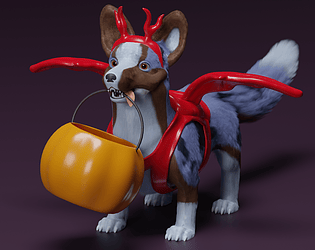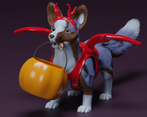Play asset pack
Speedy Boi's itch.io pageResults
| Criteria | Rank | Score* | Raw Score |
| Project Documentation | #24 | 3.266 | 4.000 |
| Research + Development | #30 | 3.266 | 4.000 |
| Final Presentation | #42 | 2.449 | 3.000 |
| Creative Development | #45 | 2.449 | 3.000 |
| Overall | #49 | 2.613 | 3.200 |
| Technical / Workflow | #56 | 1.633 | 2.000 |
Ranked from 1 rating. Score is adjusted from raw score by the median number of ratings per game in the jam.
Challenge Tier
Search For A Star
Leave a comment
Log in with itch.io to leave a comment.






Comments
(Unofficial) Industry Feedback.
Tristan McGuire:
Character Artist at Airship Interactive.
https://www.artstation.com/tristanmcguire
Research and Concept:
Great take on the prompt, nice to see that you went with your personal favourite dog breed rather than the more conventional choice. Nice to see that you used lots of references to inform your concept and even went into the details of the different corgi colourations! Your final choice of concept is well designed and I am glad to see you got external feedback to help make your choice.
It’s useful that you showed some examples of the art style you are going for, as being able to match art styles is a very important aspect of working in a studio. However I see that the examples all have sculpted fur, whereas you went for a strand based groom. It would be useful to hear how you came to that decision and to see some examples of what look you were wanting to achieve with the fur.
High poly:
Your corgi sculpt is nice – good use of exaggerating the forms to make the model stylised. Next time try including some sharp edges to contrast the smooth contours.
For the accessories, I think they would benefit from being a bit chunkier, to really push the stylised look. The harness hugs the body very closely, so it still has that feel of being a subtool extracted from the base body rather than being a separate item. Look to communicate which areas of the harness are under a lot of tension and which areas might be looser.
Low poly:
You have made a good start at including edge loops that will allow for good deformation, but next time do some more research into how to best handle the shoulder and hip areas. These areas have to be able to move quite a bit, so they are important to get right. Secondly, the overall tri count is way too high for a model of this style. A fully kitted out human in a realistic AAA game would be potentially 100k tris for cinematic-level shots. But stylised models like this are typically a lot lower. Try to keep your models to 100k tris maximum for your portfolio pieces.
When showcasing your topology, use a shader that shows the model as shaded but with the wireframe on top. It is very difficult to evaluate the quality of the model when you are seeing through to the other side.
For quadrupeds, place the pivot between all of the paws, beneath the body. Your pivot is placed too far forward.
It is good to see that you did some research into how to construct your eye. It would be even better to see you discuss the pros and cons of making eyes from multiple surfaces with real translucency, vs using single surfaces with faked refraction. This would help to show that you made an informed decision.
UVs:
The placement of your UV seams looks good. However you could have solved the face area with fewer cuts.
Would have been useful to see renders of the 2D UV layouts in this section.
Textures:
The textures unfortunately look quite rushed. They really feel like they were quickly painted on. Next time take a closer look at the way that other stylised models have been textured. A lot of stylised art relies on combining soft gradients with painted sharp edges. Adding some speckles of roughness variation to the plastic areas also helps to make the material look deliberately like plastic and not look unfinished.
Fur:
As mentioned before, your style references did not have fur, so it is hard to judge whether you achieved what you set out to do. In this section, I would have liked to see an explanation of why you chose to use a strand based groom and not hair cards and also a breakdown of the grooming process in Blender. As I have not personally seen or used Blender in a professional setting – it is very difficult for me to judge the technical aspects of this section.
Aesthetically the initial fur test does have a nice range of fur length and the clumping is nice.
Rig:
The rig looks good for the style of model. One tip is that if you place the tips of the paw joints on the ground at the very edge of the geometry, that can help when setting up the controls so that your character can lift its toes whilst keeping the heel to the ground and for lifting the heel with the toes down. Your rig looks fine as-is though, that’s just a tip that came to mind.
Posing and Final Presentation:
I love your idea for the good and bad boi poses, but it is a shame that we only got to see the running pose. It’s great that you informed your running pose based on reference, as that really helps it look believable.
The fact that the rigging caused some issues with the groom and that the groom shader looks different across the two renders is frustrating but not the end of the world really. If you are wanting to be a character artist in a studio, then you would very likely have specialist groom artists and technical artists who would assist in the production of an asset like this. If you are wanting to become a groom artist – then feel free to keep exploring the depths of groom, but if you are wanting an entry level character art job, then I would not look to experiment more with strand based groom, as that’s not a skill you will particularly need in that position.
When looking for job at a game studio, we would really like to see your models rendered in a game engine. This shows you understand how to implement assets and that you understand what can or can’t be used in a game. So next time, please push to get your assets into Unreal, rather than relying on Blender for your rendering. And show off your models from more angles. We want to see that the model looks good in 360 and that you are not hiding anything. I can see that you attached a .blend file, but as we use Maya at work, I don’t even have Blender on my PC to open it. Including a turnaround video or a Sketchfab upload helps make sure your model is accessible to all.
Final thoughts:
This is a clever design and it’s great that you tried to tackle many technical pipeline steps like groom and rigging. To improve, take a look at topology of other quadrupeds and make your next model a bit lower poly. Showcase your technical renders more professionally by taking renders of your wireframes and not using viewport screenshots. And show off your finished model from all angles.
Feel free to take a look on my ArtStation for some examples of the kinds of technical breakdowns that are expected in a graduate portfolio (Silverhand was my FMP, so all the ones from that one and backwards in time were on my graduate portfolio). And also look around at the portfolios of other recent graduates or professionals with student work still hanging around on their portfolios.
Best wishes for the future and feel free to contact me again.
So cute!